The Alhambra Palace: A Timeless Symphony of Art, Architecture, and Andalusian Splendour
Reminiscing about Granada and its sumptuous Moorish architecture gems
Happy Sunday and welcome back to Giselle daydreams! This is my last post of the year, and I’m proud to have managed to post weekly since the beginning of July.
Two years ago, I dragged my husband into a trip entirely curated by me, except for one evening in which I had to please him and attend a football game. I decided to spend two days in Granada to wander in the Alhambra Palace (and in Albaicín) to immerse ourselves in Andalusia, as I became obsessed with Moorish architecture.
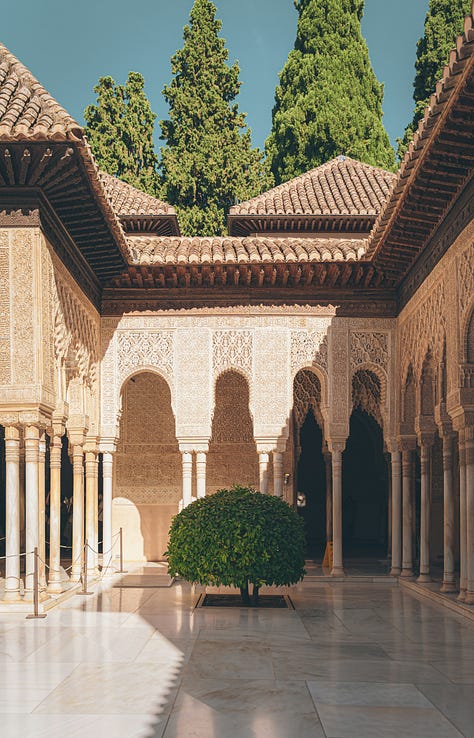
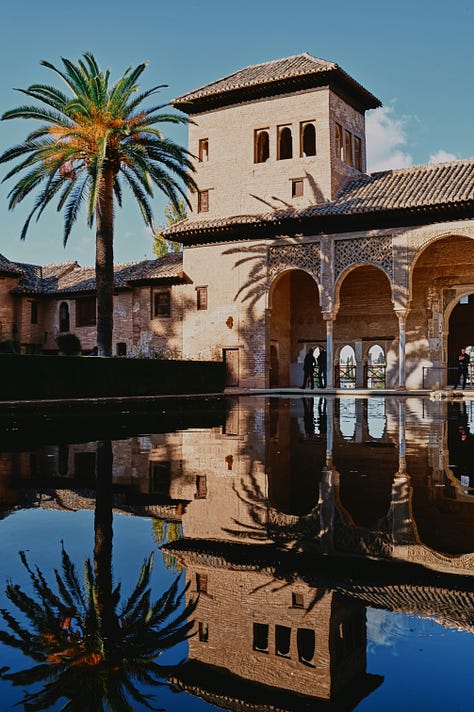
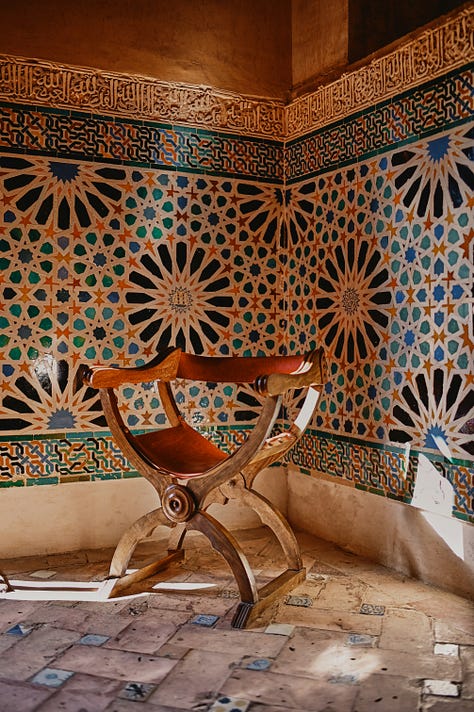
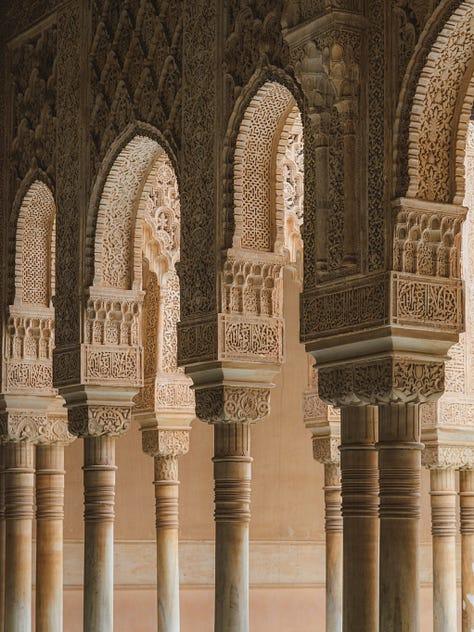
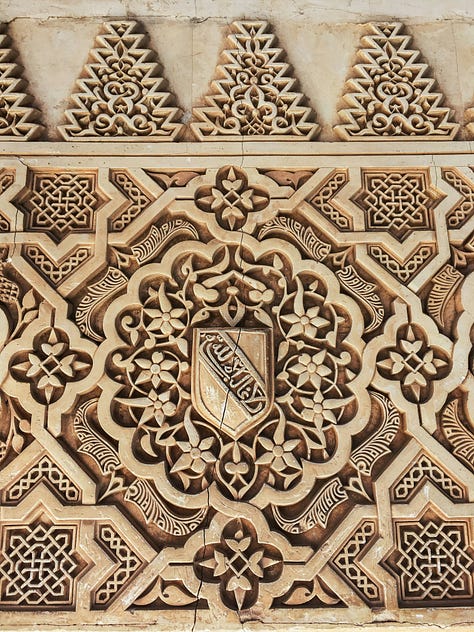
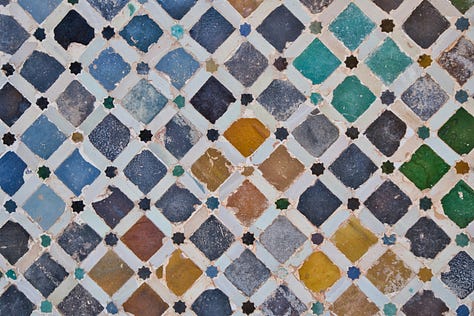
The Alhambra Palace is one of the most iconic monuments in Islamic and Spanish history. Perched atop the hills of Granada, it is a breathtaking testament to Moorish artistry and Islamic architecture. Its story reflects centuries of cultural confluence, political ambition, and artistic achievement. Constructed during the Nasrid dynasty (1238–1492), the last Muslim rulers of Spain, this sprawling complex combines military fortifications, palatial residences, and serene gardens into an awe-inspiring masterpiece.
The site of the Alhambra has been occupied since Roman times, however, its transformation into a fortress began in the 9th century under the rule of Sawwar ibn Hamdun during the fragmented era of Al-Andalus. However, the Alhambra Palace we recognise today started to take shape in the 13th century under the Nasrid dynasty, the last Muslim rulers of Spain. In 1238, Muhammad I ibn al-Ahmar, founder of the Nasrid dynasty, made Granada his capital and began the construction of the Alhambra as a fortified palace complex. Over the next two centuries, his successors expanded and refined the Alhambra into a dazzling seat of power.
The Nasrid Palaces, the heart of the Alhambra, were built to embody the dynasty's vision of a paradise on Earth. The palaces reflect the height of Islamic architecture, blending practicality with opulent decoration. Muhammad II (1273–1302) strengthened the defensive aspects of the Alhambra, including the outer walls and towers. Yusuf I (1333–1354) and Muhammad V (1354–1359, 1362–1391) oversaw the construction of the most iconic features, including the Palacio de Comares (Hall of the Ambassadors) and the Palacio de los Leones (Court of the Lions). These spaces symbolised the political power, artistic sophistication, and spiritual devotion of the Nasrid court. The Alhambra was not just a royal residence but also a cultural and administrative centre. Scholars, poets, and artisans thrived under Nasrid's patronage, creating a vibrant intellectual atmosphere within its walls.
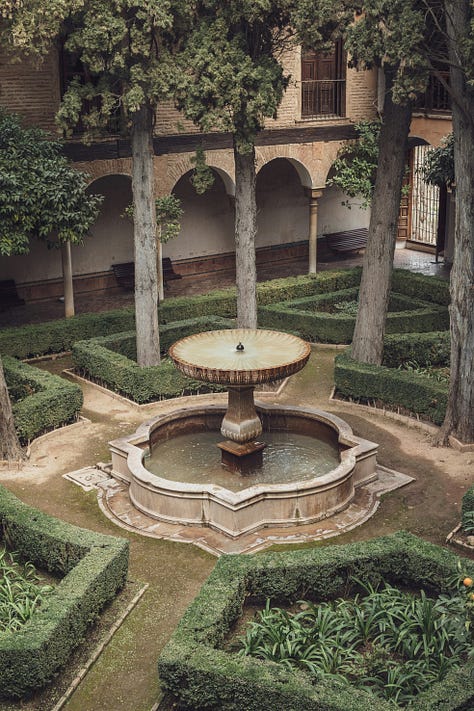
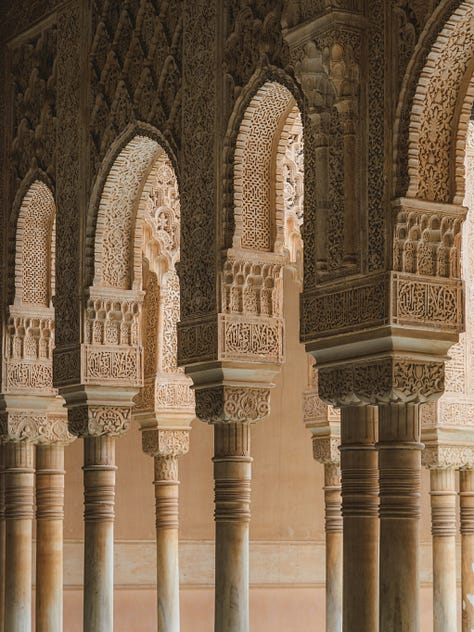
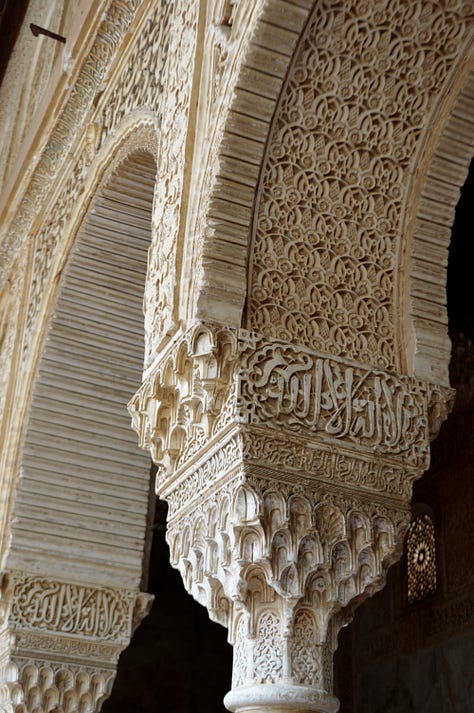
The Nasrid dynasty faced growing pressure as the Christian Reconquista gained momentum. In 1492, Granada, the last Muslim stronghold in Spain, fell to the Catholic Monarchs Ferdinand, King of Aragon and King of Castille and his joint sovereign Isabella. The handover of the Alhambra Palace marked the end of Muslim rule in Spain. After the conquest, the Alhambra Palace became the royal court of Ferdinand and Isabella. It was here that Christopher Columbus received their support for his journey to the New World. While the new rulers preserved much of the complex, they also modified it to suit their Christian tastes, including the construction of a Renaissance-style palace by Emperor Charles V.
Following the fall of the Nasrids, the Alhambra Palace entered a period of decline. Over centuries, it was used as military barracks and suffered from neglect, vandalism, and natural disasters. Much of its original splendour was lost, including vibrant painted decorations.
The 19th century saw a renewed interest in the Alhambra, sparked by romantic travellers and writers like Washington Irving, whose book Tales of the Alhambra (1832) brought global attention to its beauty and history. This prompted preservation efforts to restore the complex. In the 20th century, the Alhambra was declared a UNESCO World Heritage Site (1984), ensuring its protection and recognition as a cultural treasure.
At the heart of the Alhambra lies the Nasrid Palaces, a series of intricately designed royal quarters that reflect the height of Islamic architectural sophistication. These palaces are renowned for their exquisite interplay of geometry, light, and ornamental detail. The Palacio de Comares and the Palacio de los Leones are the two most celebrated sections, each showcasing distinct features that emphasize beauty and balance.
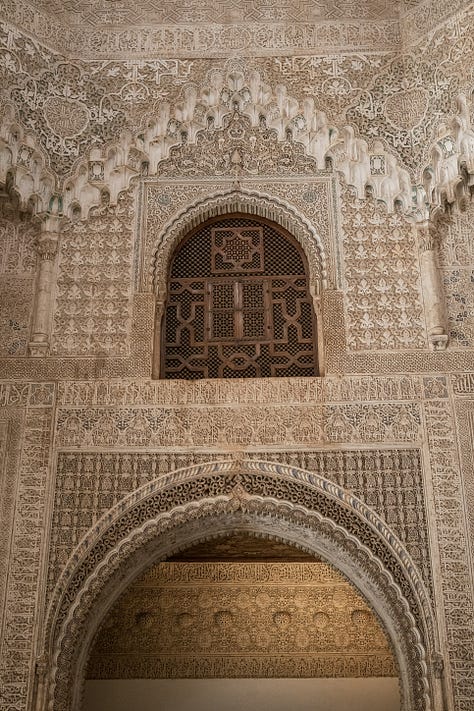
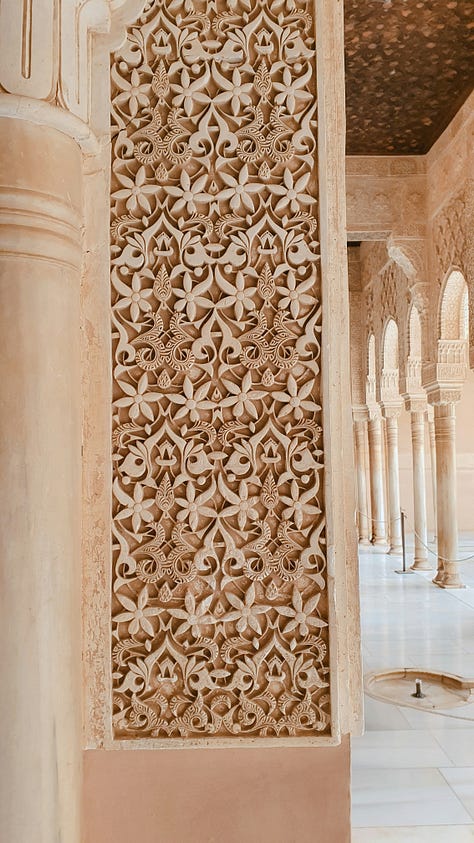
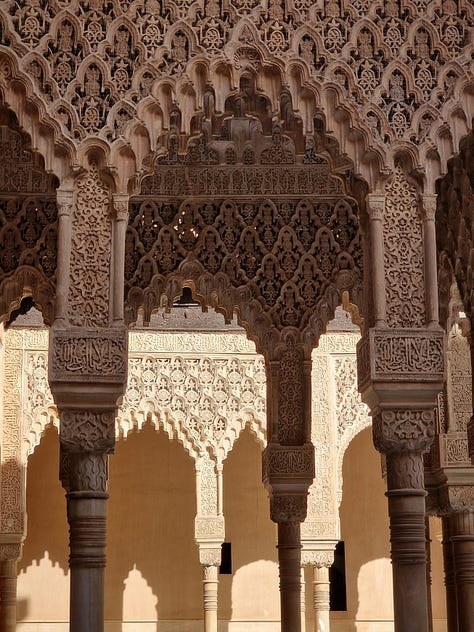
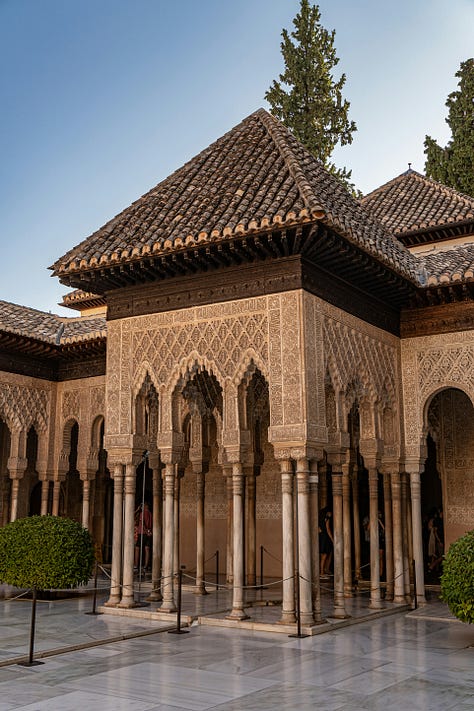
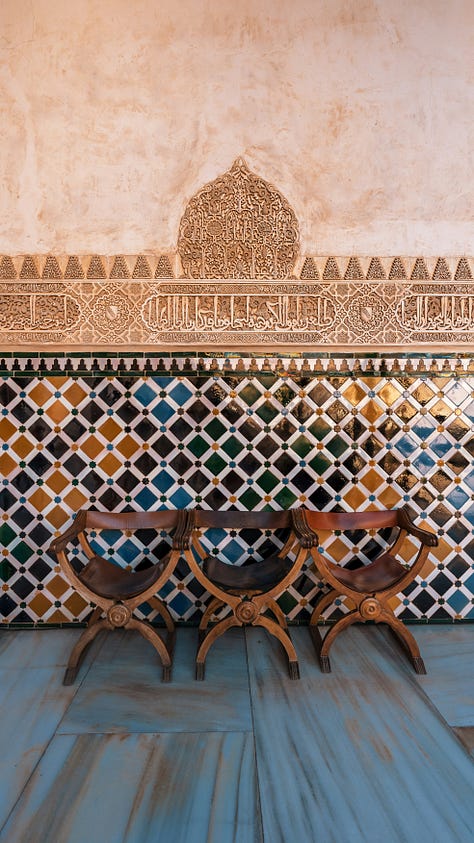
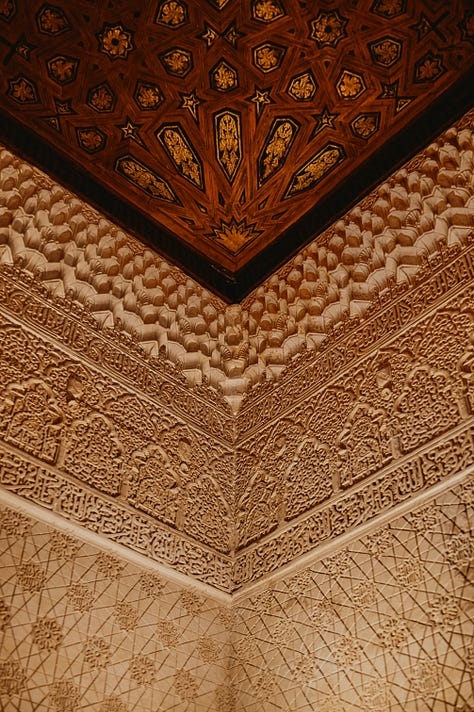
A defining characteristic of Nasrid architecture is its attention to detail. The walls of the Nasrid Palaces are adorned with over 10,000 inscriptions, most of which are Arabic poetry, Qur’anic verses, and praises to Allah. A recurring phrase is "Wa la ghalib illa Allah" ("There is no victor but Allah"), which served as the motto of the Nasrid dynasty. Some inscriptions are even riddles or puzzles, blending art and intellect. Furthermore, the walls are also adorned with arabesques, calligraphy, and geometric patterns that demonstrate both artistic skill and spiritual devotion.
The interplay of light and shadow in the Nasrid Palaces is intentional and deeply symbolic. The use of light and shadow creates dynamic interiors, while water features — pools, fountains, and canals — introduce a sense of tranquillity and reflection. The sunlight streams through latticed windows and shifts throughout the day, casting patterns that evoke spirituality and the transient nature of life.
The Palacio de Comares, the formal residence of the sultans, is centred around the Courtyard of the Myrtles (Patio de los Arrayanes), where a tranquil pool reflects the delicate arches and latticed windows. The architecture employs optical illusions to enhance its grandeur. For instance, the reflection of the Patio de los Arrayanes in its long pool makes the space feel larger and more symmetrical than it actually is. Similarly, the intricate muqarnas (honeycomb stucco) ceilings appear weightless, creating an illusion of celestial infinity. The Hall of the Ambassadors (Salón de los Embajadores) within this palace features soaring ceilings adorned with intricate wooden inlays and stucco decorations that evoke celestial imagery.
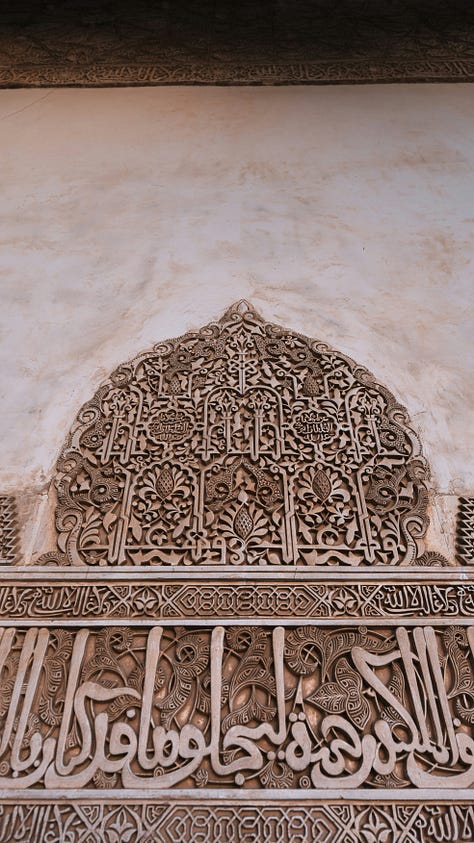
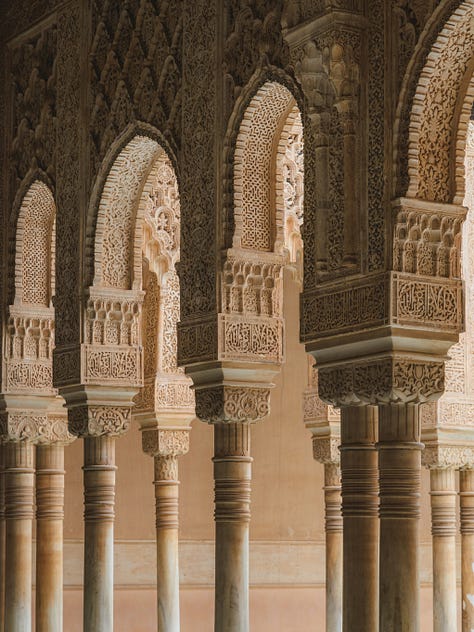
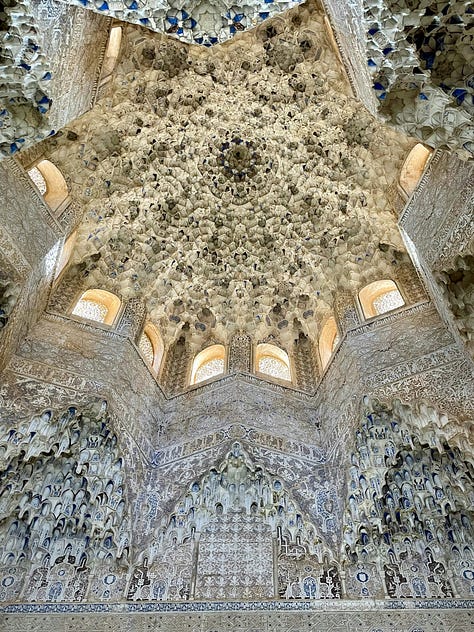
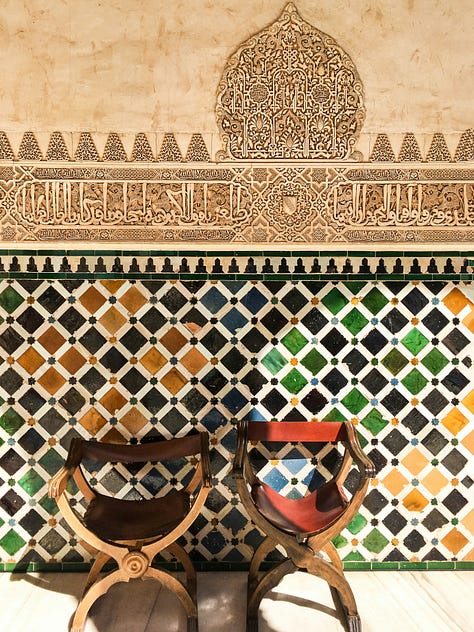
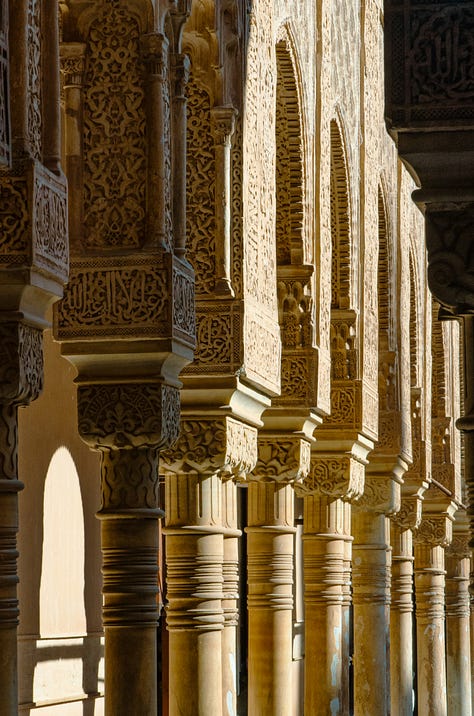
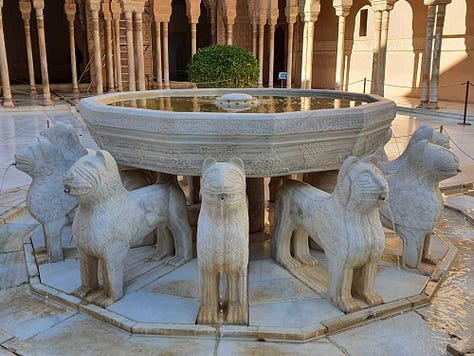
The Palacio de los Leones, built under Sultan Muhammad V, is famous for the Courtyard of the Lions, a mesmerising space surrounded by slender marble columns. At its centre stands the iconic fountain supported by twelve marble lions, each symbolizing strength and power. The surrounding halls, like the Hall of the Abencerrajes and the Hall of the Two Sisters, are adorned with muqarnas (stalactite-like plasterwork), delicate tile mosaics, and Arabic inscriptions that glorify the divine.
The Nasrid architects ingeniously incorporated water not just for beauty but also for functionality. Pools, fountains, and canals throughout the complex helped cool the palaces during the scorching Andalusian summers, acting as a natural air-conditioning system. The iconic Fountain of the Lions in the Courtyard of the Lions was not merely decorative — it functioned as a sophisticated hydraulic system. Water flowed from the mouths of the marble lions in a precise rhythm that reportedly represented the hours of the day, an advanced feat of engineering for its time.
The Nasrid architects used advanced mathematical principles in their designs. The geometric patterns in the tiles and carvings reflect the Islamic emphasis on infinity and unity, with shapes that can infinitely tessellate without gaps. These patterns also have mathematical roots in symmetry and fractals, centuries before such concepts were formally recognised.
The Alhambra Palace’s architecture embodies the Nasrids' vision of paradise on Earth. It seamlessly blends natural elements with human craftsmanship, making it not only a historical treasure but also an enduring symbol of the cultural and artistic achievements of Islamic Spain. Some researchers suggest that parts of the Alhambra Palace align with astronomical events. For instance, the positioning of windows and courtyards may have been designed to correspond with solstices or other celestial phenomena, reflecting the Islamic interest in astronomy.
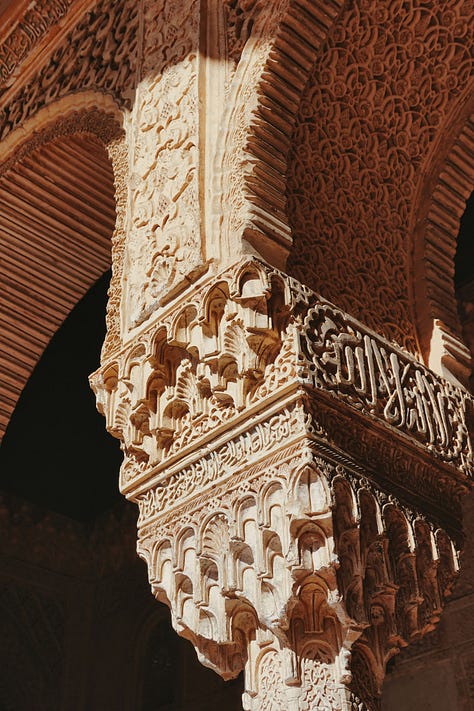
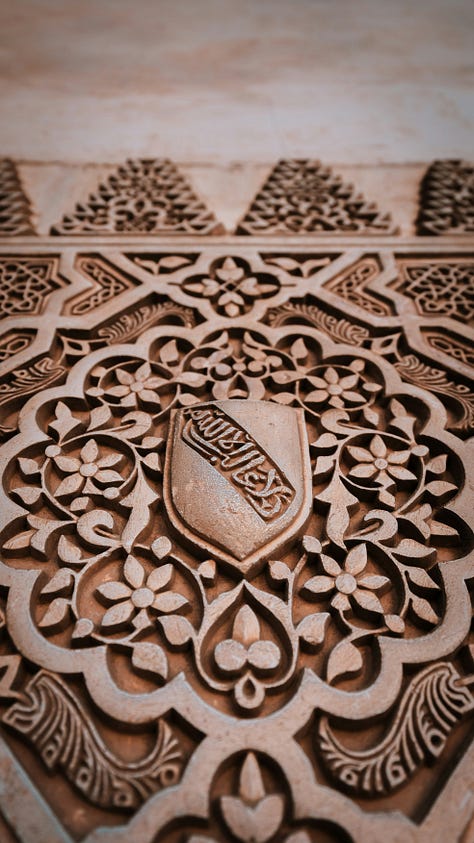
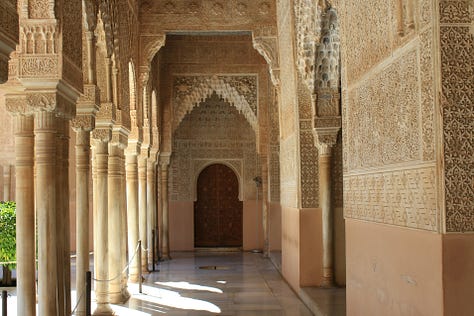
While today the walls and carvings of the Alhambra Palace appear white or neutral, they were originally painted in vibrant colours like red, blue, and gold. Traces of these pigments can still be seen under careful observation, hinting at the palace’s once-dazzling appearance.
The Alhambra Palace has survived numerous earthquakes over the centuries due to its flexible architectural techniques. Wooden beams in the walls and ceilings absorb shocks, a design far ahead of its time.
The Alhambra and its Nasrid Palaces stand as a testament to the brilliance of Islamic civilisation in Spain. It embodies the artistic, scientific, and architectural achievements of Al-Andalus, as well as the resilience of Granada’s unique cultural legacy. The Alhambra Palace’s architecture is not just a feast for the eyes; it is a marvel of engineering, mathematics, and artistry, laden with hidden meanings and advanced techniques. Despite its tumultuous history, the Alhambra Palace continues to inspire awe and remains a bridge between the past and present. Today, it is one of Spain’s most visited landmarks and a symbol of the country’s rich multicultural heritage.
I hope you enjoyed today’s post. If you enjoy my travel content, you can read my Lisbon travel diary, three museums to visit in Madrid, and my favourite museums in the South of France.
As always, thank you for reading. Please keep liking, commenting, sharing and subscribing. It helps the newsletter grow and reach like-minded readers.
FIN.



This post reminds me what an incredible impact traveling East had on Frederic Church. His home in the Hudson Valley is not far from mine, and is incredibly intricate in detail after the style you present here. He traveled to Petra and other preserved middle eastern architecture to collect as much information as he could and infused it into Olana.
Injudt love the Alhambra and Granada and Andalucia.
Visited three times, it's just magical, if it weren't for the people.